Cacti and succulents are often lumped together. While they do share similar characteristics, there are some differences.
Around 60 different plant families are classified as succulents, while cacti are all part of one family (Cactaceae).
Succulents are water-storing plants. They generally grow in arid environments, so they store their own water to make it through extended dry periods.
If that sounds like a cactus to you, you’re right. The Cactaceae family is included in the list of 60ish succulent families. So, to put it simply, all cacti are succulents, but not all succulents are cacti. That certainly isn’t a deep dive into the cacti/succulent distinctions, but it’s a basic overview.
When many people think of cacti, they immediately think of the desert giants they’ve seen in Hollywood westerns. But there are a whole host of cacti types that make wonderful houseplants, the same way that many succulents do. Here are five such cacti that could make a lovely, and super low-maintenance, addition to your plant stand or windowsill.
1. Bunny Ear Cactus (Opuntia microdasys)
Also known as the “angel’s wings” or “polka-dot” cactus, the bunny ear cactus is an adorable little plant that is perfect for the cactus novice. It requires very little maintenance and will make a wonderful conversation piece.
This member of the prickly pear family is native to Mexico. The clusters of pads grow to a maximum height of two feet tall but can spread up to five feet across. Growth is quite slow, and proper pruning techniques can keep it at the desired size for your space.
The bunny ear cactus is recommended for year-round outdoor growing in Zones 9a-11b. If you reside in a lower plant hardiness zone, you’ll need to grow this cactus in containers that can be moved inside or as a permanent houseplant.
The bunny ear cactus requires direct sunlight, preferably for 6-8 hours a day. A sunny window is a great option when growing indoors. If you don’t have a spot in your home that receives enough daily sunlight, you can use grow lights as a supplement.
While your pets should never have access to any cactus due to the spines, some are more dangerous than others. The bunny ear cactus falls in the less dangerous category. It is classified as non-toxic for pets.
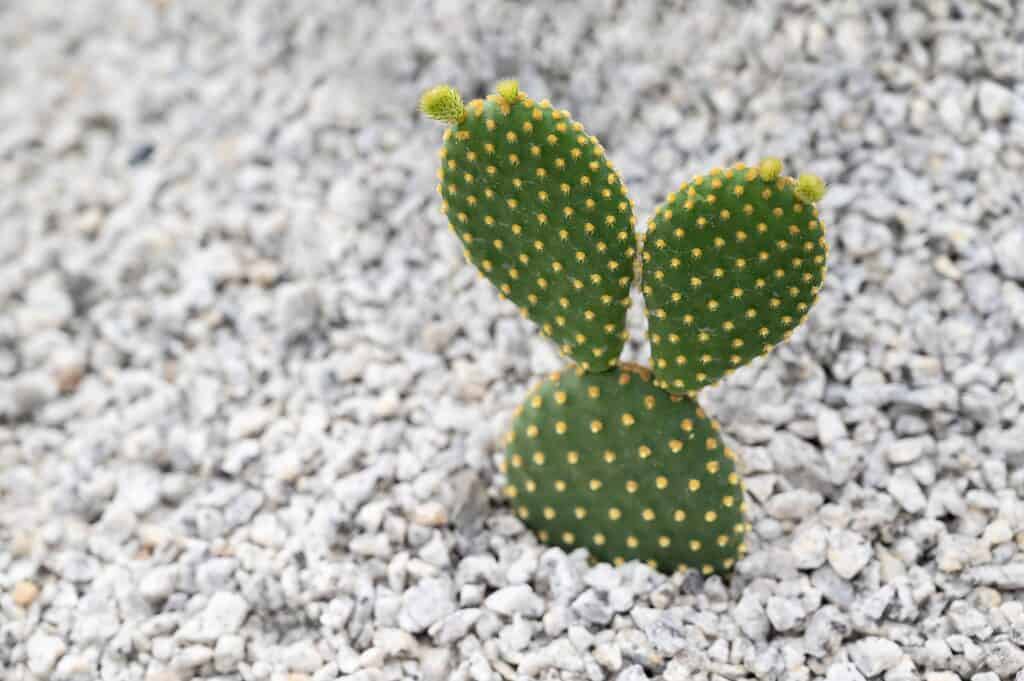
This cactus looks so much like a bunny that you may wonder if it will hop away. Don’t worry. It won’t.
©Nooumaporn/Shutterstock.com
2. Rat Tail Cactus (Aporocactus flagelliformis)
This showy cactus is an ideal option for a hanging basket. The rat tail cactus (sometimes called the “monkey tail” cactus) features trailing stems that can grow up to four feet in length.
Endemic to Mexico and Central America, this cactus flowers in the spring with relatively large tubular magenta blooms. Occasionally the flowers can display hues of orange or pink. Historically, indigenous peoples used these blooms to treat heart issues.
Outdoor growing is limited to Zones 10a-11b, but this cactus makes a great houseplant if it gets enough light. Like most cacti, the rat tail cactus requires direct sun for a minimum of six hours a day.
When considering placement, remember that the long spine-filled stems can easily snag passersby, which is a rather unpleasant experience. A high-traffic area is not the ideal place for this trailing cactus.
The rat tail cactus is classified as toxic for pets. Keep the kitties and doggos away.
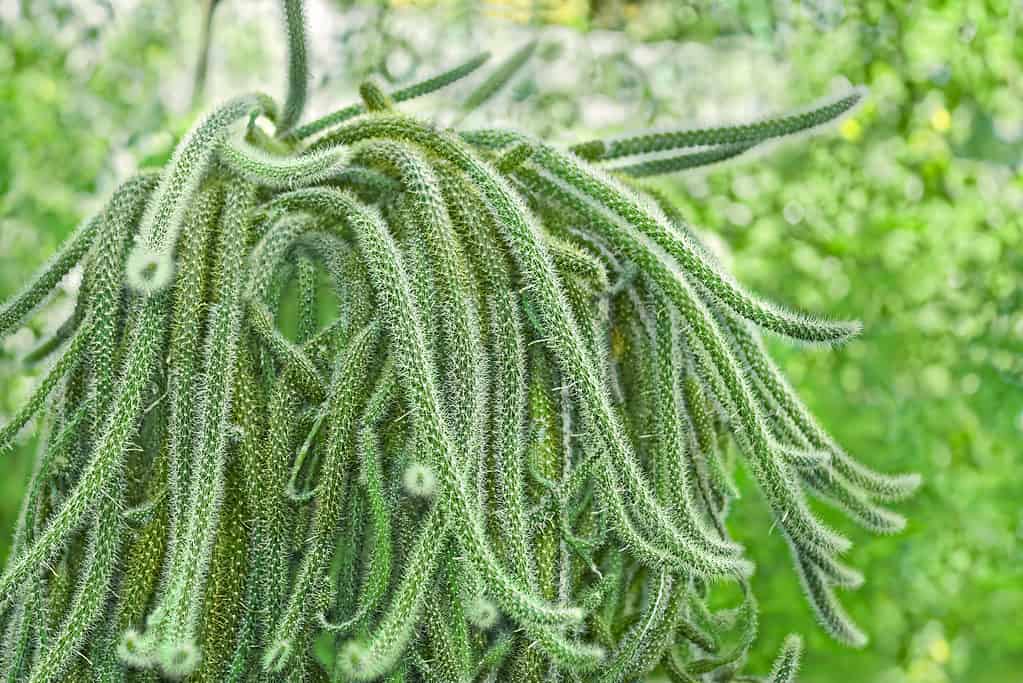
The trailing stems of the rat tail cactus can grow up to four feet long.
©Marykit/Shutterstock.com
3. Christmas Cactus (Schlumbergera bridgesii)
Also known as the holiday cactus, this particular cactus isn’t necessarily more festive than others. It just happens to bloom around the holidays if timed correctly. Those blooms certainly add another layer of beauty to the season, alongside poinsettias and Christmas trees. So, maybe that does make it the most festive cactus, after all!
How exactly do you time things out so these lovely pink or white flowers bloom during the holidays? Well, you could ask Santa to bring you some flowers for Christmas, or you could expose your Christmas cactus to cooler temperatures (50-60°F) as winter approaches. This will coax your Christmas cactus to flower.
The Christmas cactus lacks the sharp, foreboding spines featured by many other varieties of cacti. Instead, it displays segmented leaves with rounded, soft spines. And that’s not the only difference between this cactus and many other varieties. Caring for a Christmas cactus is a significant departure from typical cactus care.
This cactus is native to the rain forests of Brazil rather than the arid, desert climates where most cacti are found. The Christmas cactus needs filtered light rather than direct sun, as well as much more regular watering than most other cacti.
Despite its wintry name, the Christmas cactus is not frost-tolerant and is only recommended for outdoor growing in Zones 10-12.
It is non-toxic and safe for pets.
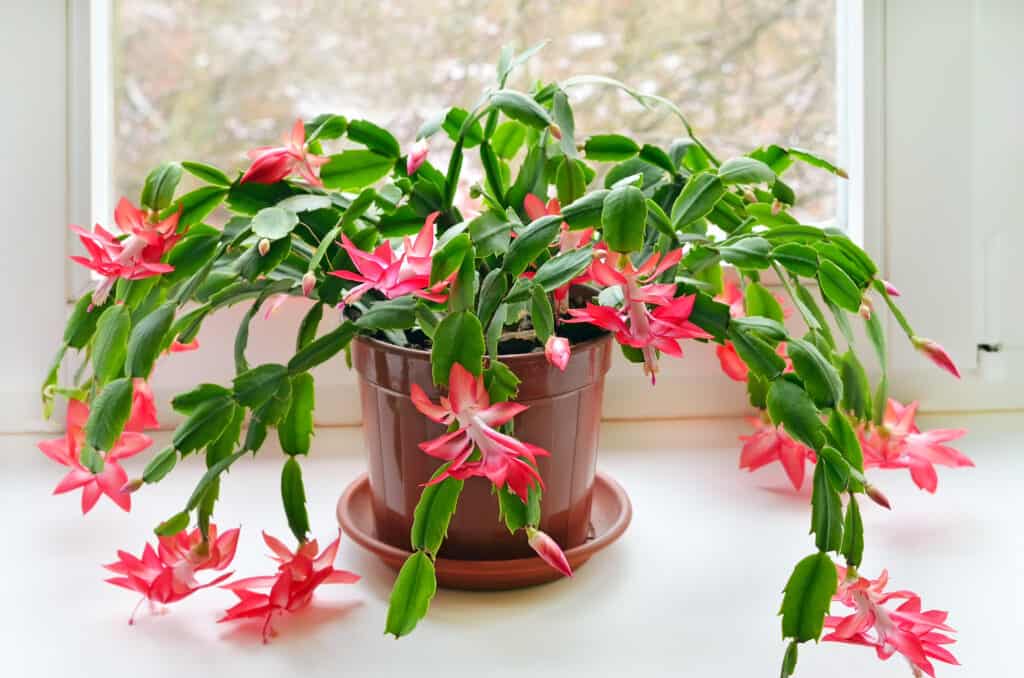
With proper timing, the Christmas cactus will display spectacular blooms during the holidays.
©iStock.com/Nadezhda_Nesterova
4. Feather Cactus (Mammillaria plumosa)
The white plumes (“feathers”) on this little cactus appear downy and soft, but they actually conceal some rather sharp spines underneath. This wispy covering also helps to protect the cactus from the heat and sun of its native Mexico.
This cactus is low-growing, only reaching heights of around four inches. Given time (5-10 years), the cactus will spread wide, growing in clumps that can cover over three feet of ground.
It is not a very cold-hardy plant and recommended outdoor growing is limited to Zones 9a-11b. When growing indoors, ample sunlight (or supplemental grow lights) will help the feather cactus thrive.
The blooms of this cactus appear in various shades of white with occasional hues of pink. The flowers have a daisy-like structure and emit a strong and very sweet fragrance.
The feather cactus is non-toxic.
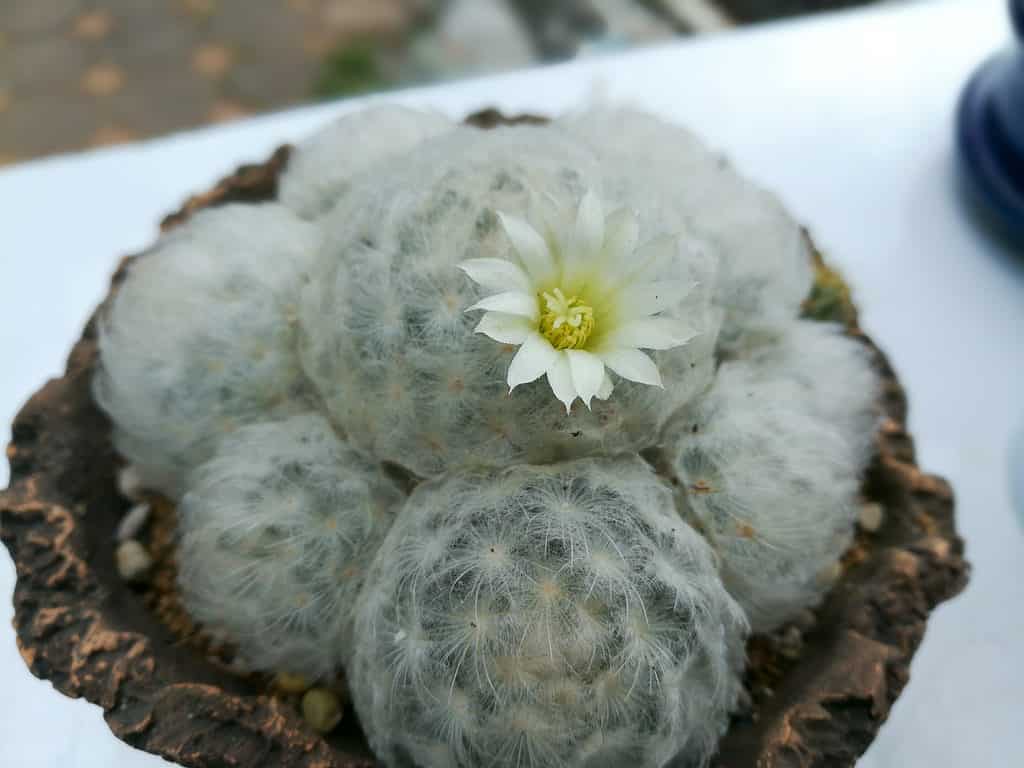
The feathery-looking exterior and the beautiful white bloom of the feather cactus are hiding some pretty sharp spines underneath.
©Jakchai SK/Shutterstock.com
5. Moon Cactus (Gymnocalycium mihanovichii)
The moon cactus is also known as the “ruby ball” cactus, “star flowered” cactus, and “red cap.” It’s easy to see why this particular succulent bears such vibrant, colorful names.
This cactus is a mutant, of sorts. Two cacti join together to form the moon cactus. The colorful top (known as the scion) is the Gymnocalycium mihanovichii. The lower cactus is normally a Hylocereus, but the species can vary.
The upper scion cannot photosynthesize, which is why it must be connected to a rootstock cactus for nutrients. It is the lack of chlorophyll that gives the scion its dazzling colors, ranging from bright orange to hot pink to neon yellow. Anyone who believes cacti are boring has never seen one of these eye-catching succulents!
Most of the usual rootstock species, which provide 100% of the scion’s nutrients, require typical cactus care. Plenty of sunshine and minimal watering is required. While they are officially rated for Zones 10a-11b, few gardeners grow them outdoors. The moon cactus is almost exclusively grown as a potted plant.
If there is a downside to the moon cactus, it would be that its lifespan is relatively short, even with proper care. The two cacti that are grafted together grow at different rates, which will eventually destroy the graft union that binds them together. You can separate them and re-graft the upper scion onto a new rootstock plant to extend its life.
It is classified as non-toxic for pets.
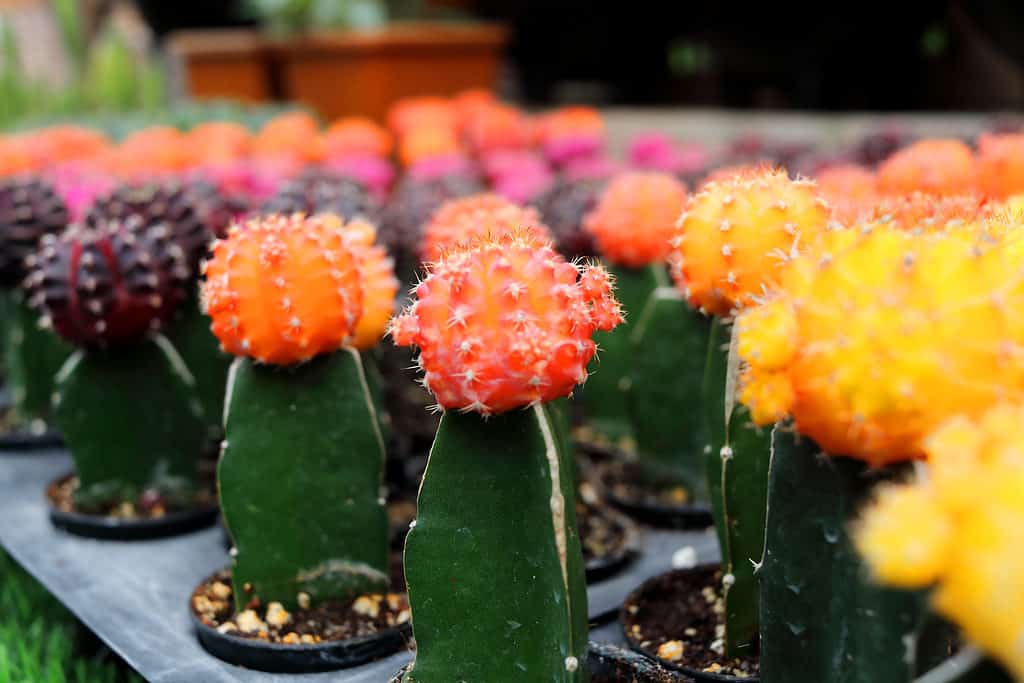
The yellow, orange, and even dark violet colors of moon cacti are stunning!
©Kanjana Wattanakungchai/Shutterstock.com
Final Thoughts
These cacti succulents, and many others like them, are great for both novice and neglectful gardeners. While there are some that require a bit more care, such as the Christmas cactus, most need very little attention to thrive.
Plant them in a standard cactus or succulent potting mix, providing lots of sunshine and watering only when the soil is completely dry. That’s normally all it takes for these fascinating cacti succulents to thrive!
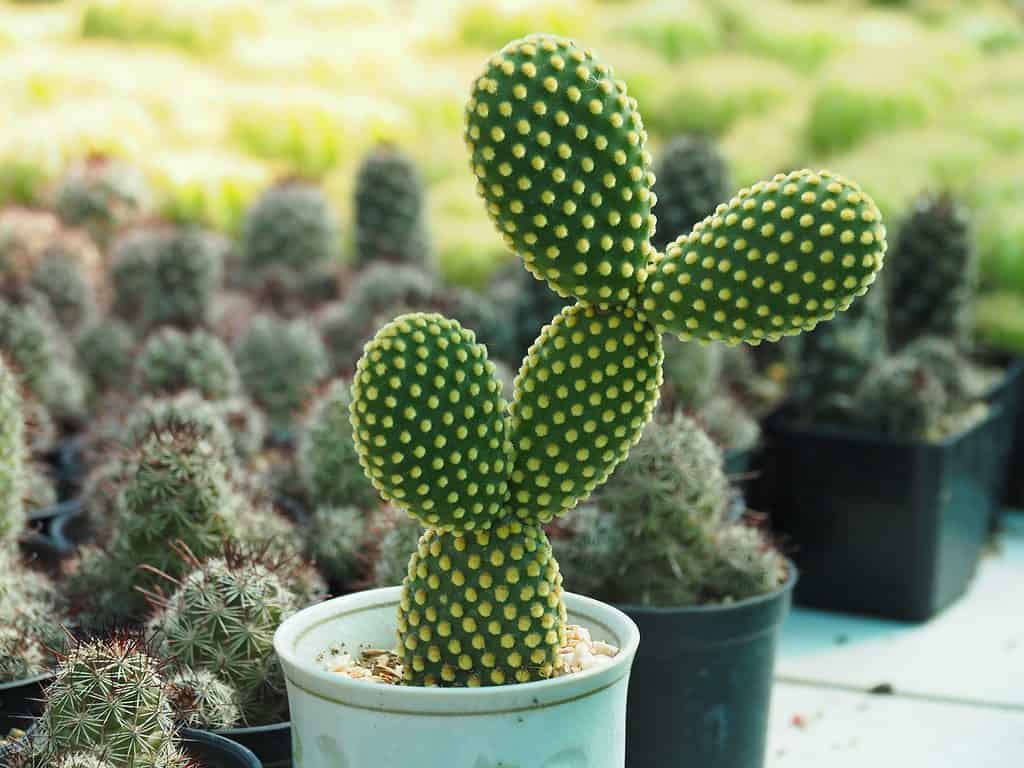
Many cacti succulents, such as this bunny ear cactus, make great potted plants.
©Mon_camera/Shutterstock.com
The photo featured at the top of this post is © Yongkiet Jitwattanatam/Shutterstock.com
Thank you for reading! Have some feedback for us? Contact the AZ Animals editorial team.






